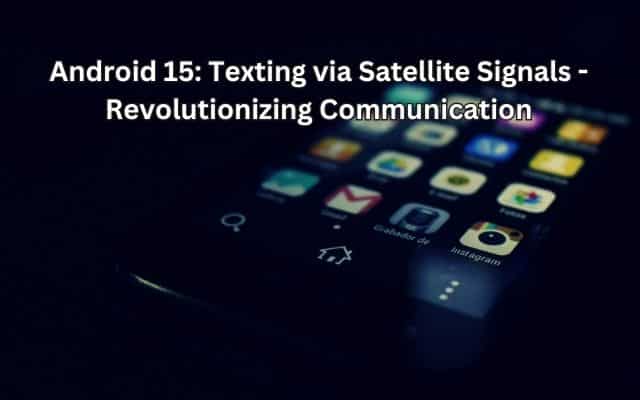Android 15 Might Let You Send Text Messages via Satellite: A New Era in Communication

In the ever-evolving world of technology, Android 15 is set to redefine our communication norms. Imagine being in the remotest corner of the world, far from any cell tower, yet being able to send a text message. Sounds like a dream, right? Well, Android 15 is turning this dream into reality by introducing the ability to send text messages via satellite.
This groundbreaking feature promises to revolutionize the way we communicate, making it possible to stay connected no matter where we are. It’s not just about convenience, but also about ensuring safety and accessibility in areas where traditional cellular networks can’t reach.
Stay tuned as we delve deeper into this exciting new feature of Android 15, exploring its potential benefits, applications, and the challenges it might face. Welcome to a new era in communication, powered by Android 15’s satellite text messaging.
Android 15 and Its Features
Android 15, the latest iteration of Google’s popular mobile operating system, is packed with a host of new features and improvements. It continues the tradition of enhancing user experience, security, and functionality. But the feature that stands out the most in this release is the ability to send text messages via satellite.
This innovative feature is a result of a partnership between T-Mobile and SpaceX. The collaboration aims to leverage SpaceX’s Starlink satellites to provide Direct to Cell connectivity. This allows Android 15 devices to send and receive text messages even when traditional cellular or Wi-Fi connections are unavailable.
The satellite messaging feature is designed to work with existing LTE phones whenever you can see the sky. This makes it a potentially life-saving feature in emergency situations where cellular infrastructure is destroyed or unavailable.
However, it’s important to note that the feature comes with certain limitations. For instance, text messages may take longer to send and will only be available in some areas. Moreover, the connection can be negatively impacted by cloudy days and other weather occurrences, as well as structures.
Despite these challenges, the satellite text messaging feature in Android 15 represents a significant step forward in mobile communication technology. It not only enhances the functionality of Android devices but also has the potential to make communication more accessible and reliable, especially in remote areas and during emergencies.
Next, we will delve deeper into this revolutionary feature, exploring its potential benefits and real-world applications. Stay tuned!
Satellite Text Messaging: A Revolutionary Feature
Satellite text messaging, a standout feature in Android 15, is a game-changer in the realm of mobile communication. This feature allows users to send and receive text messages via satellite when traditional cellular or Wi-Fi connections are unavailable.
The integration of this feature in Android 15 is a result of a partnership between T-Mobile and SpaceX. Their goal is to leverage SpaceX’s Starlink satellites to provide Direct to Cell connectivity. This means that Android 15 devices can maintain communication even in remote areas or during emergencies where traditional network infrastructure may be compromised.
For the best connection, users are advised to keep a clear view of the sky. This feature is not just about convenience; it’s about ensuring safety and accessibility. With satellite text messaging, Android 15 users can contact anyone they know, in addition to emergency services.
However, it’s important to note that this feature comes with certain limitations. For instance, text messages may take longer to send and will only be available in some areas. Moreover, the connection can be negatively impacted by cloudy days and other weather occurrences, as well as structures.
Despite these challenges, the satellite text messaging feature in Android 15 represents a significant step forward in mobile communication technology. It not only enhances the functionality of Android devices but also has the potential to make communication more accessible and reliable, especially in remote areas and during emergencies.
Next, we will delve deeper into the benefits of this revolutionary feature and its potential real-world applications. Stay tuned!
Benefits of Satellite Text Messaging
Satellite text messaging, as introduced in Android 15, brings a host of benefits that could potentially revolutionize mobile communication.
Accessibility in Remote Areas: One of the most significant advantages of satellite text messaging is its ability to provide connectivity in remote areas. Traditional cellular networks often fail to cover such areas, but with satellite text messaging, users can stay connected no matter where they are.
Emergency Communication: In emergency situations where cellular infrastructure may be compromised, satellite text messaging can be a lifesaver. It allows users to send distress signals or communicate vital information when other means of communication are unavailable.
Greater Freedom and Flexibility: Satellite text messaging offers users greater freedom and flexibility in their communication. They are no longer bound by the limitations of cellular networks and can communicate freely from anywhere.
Potential for Future Developments: The introduction of satellite text messaging in Android 15 opens up a world of possibilities for future developments. It paves the way for more advanced features and applications that leverage satellite technology.
However, it’s important to note that while satellite text messaging offers numerous benefits, it also comes with its own set of challenges and limitations, which we will discuss in the next. Stay tuned!
Potential Drawbacks and Concerns
While satellite text messaging in Android 15 brings numerous benefits, it’s important to acknowledge the potential drawbacks and concerns associated with this technology.
Limited Coverage: Satellite text messaging is only available in “some areas”. This means that users in certain locations may not be able to use this feature.
Weather and Structural Interference: The connection can be negatively impacted by cloudy days and other weather occurrences, as well as structures. This could potentially limit the reliability of satellite text messaging.
Delayed Messages: Text messages may take longer to send via satellite. This could be a significant drawback for users who require instant communication.
Complexity of Information: Texting is designed for short, straightforward messaging and is poor at conveying complex or subtle information. If users want to convey something complicated, they might be better off using another form of communication.
Potential Costs: While the exact costs are not specified, using satellite technology for text messaging could potentially incur additional charges. Users would need to consider this when deciding whether to use this feature.
Despite these potential drawbacks, the introduction of satellite text messaging in Android 15 represents a significant advancement in mobile communication technology. It’s a step towards a future where communication is possible anywhere, anytime. However, it’s important for users to be aware of these potential issues and make an informed decision about using this feature.
- Best Tips to Use Microsoft Copilot on Android and iPhone
- How to Create and Use a Twitter Circle on Android and iOS
- How to Delete Apps on Your Android Device
FAQ: Android 15 Might Let You Send Text Messages via Satellite
What is the satellite text messaging feature in Android 15?
It’s a new feature that allows users to send and receive text messages via satellite when traditional cellular or Wi-Fi connections are unavailable.
How does the satellite text messaging feature work?
This feature works by leveraging SpaceX’s Starlink satellites to provide Direct to Cell connectivity. It’s designed to work with existing LTE phones whenever you can see the sky.
What are the benefits of satellite text messaging?
The main benefits include accessibility in remote areas, emergency communication, greater freedom and flexibility, and potential for future developments.
What are the potential drawbacks of satellite text messaging?
Potential drawbacks include limited coverage, weather and structural interference, delayed messages, complexity of information, and potential costs.
Is satellite text messaging available everywhere?
No, satellite text messaging is only available in “some areas”. The connection can also be negatively impacted by cloudy days and other weather occurrences, as well as structures.
Does satellite text messaging incur additional charges?
While the exact costs are not specified, using satellite technology for text messaging could potentially incur additional charges.
Is satellite text messaging a standard feature in all Android 15 devices?
As of now, this feature is a result of a partnership between T-Mobile and SpaceX. It’s unclear whether this feature will be available in all Android 15 devices or only those connected to T-Mobile’s network.
Conclusion: Android 15’s Satellite Text Messaging – A Leap Towards the Future
Android 15’s satellite text messaging feature marks a significant milestone in the evolution of mobile communication. By enabling text messaging via satellite, Android 15 has expanded the boundaries of connectivity, bringing the world closer together.
This feature promises to provide accessibility in remote areas and ensure communication during emergencies. It represents a leap towards a future where communication is possible anywhere, anytime.
However, like any new technology, it comes with its own set of challenges and limitations. From limited coverage to potential costs, these are hurdles that need to be addressed as this technology evolves.
Despite these challenges, the introduction of satellite text messaging in Android 15 is a testament to the relentless pursuit of innovation in technology. It’s a step towards a more connected world, and we can’t wait to see what the future holds.
As we continue to explore the potential of this feature, one thing is clear: Android 15’s satellite text messaging is not just a feature; it’s a revolution in mobile communication. And we are just getting started. Stay tuned for more updates on this exciting development!






